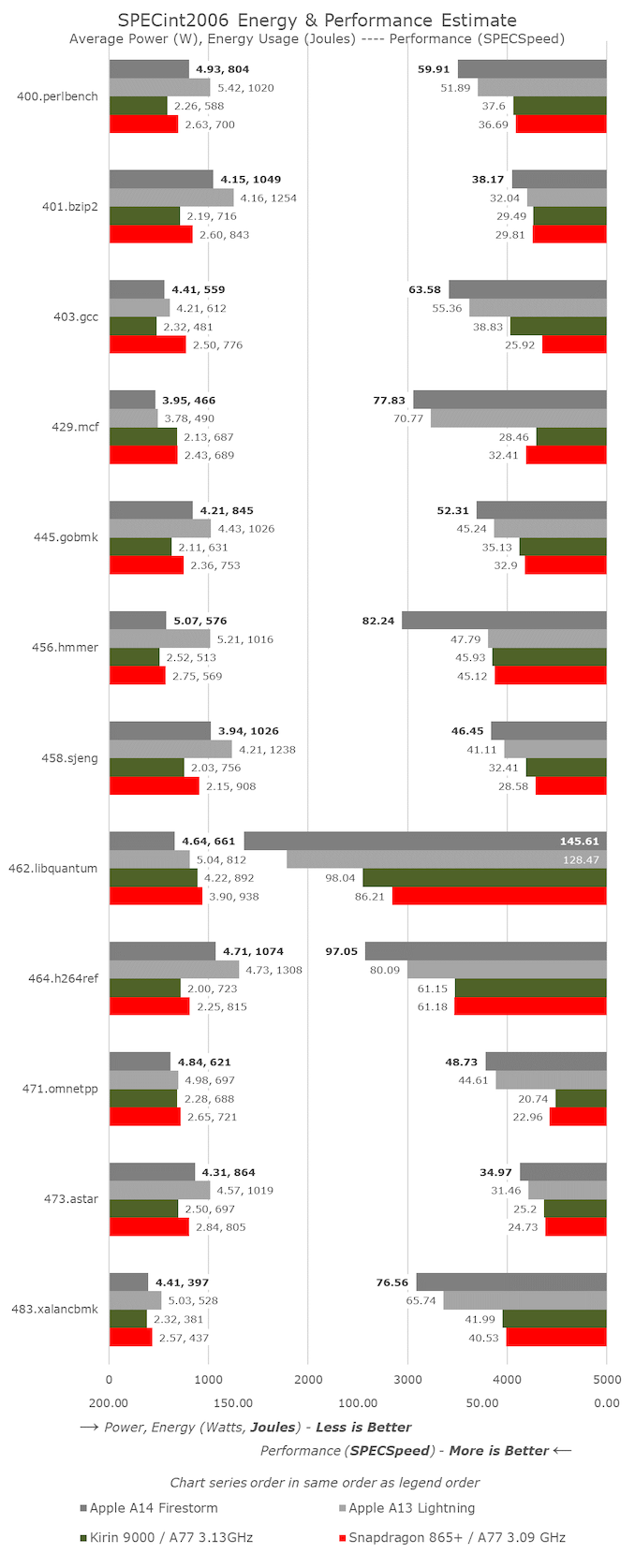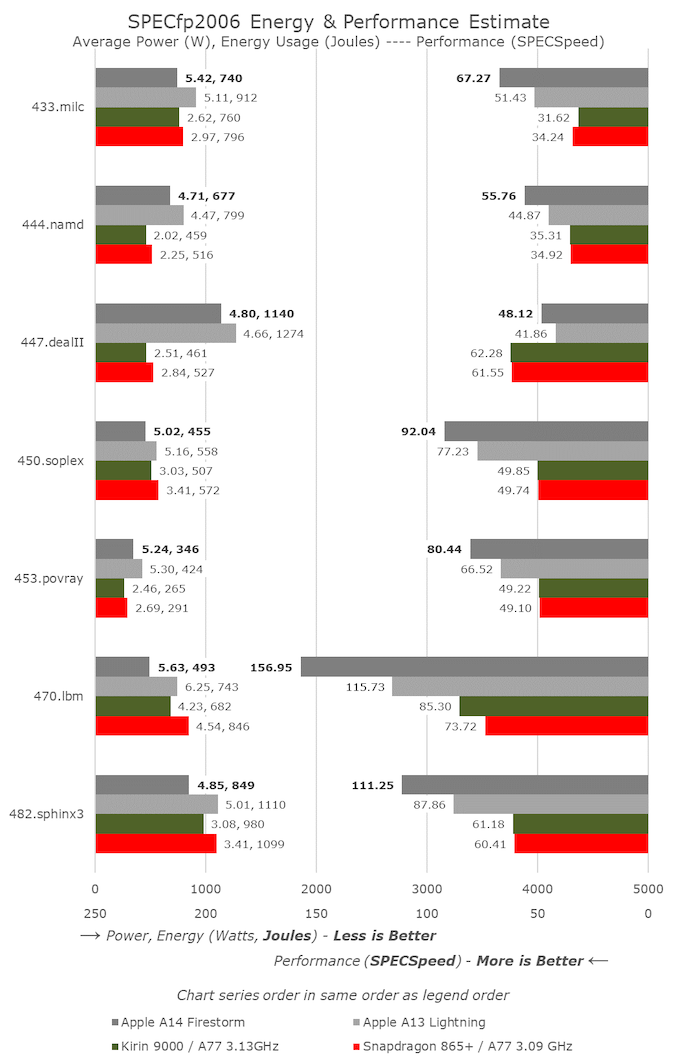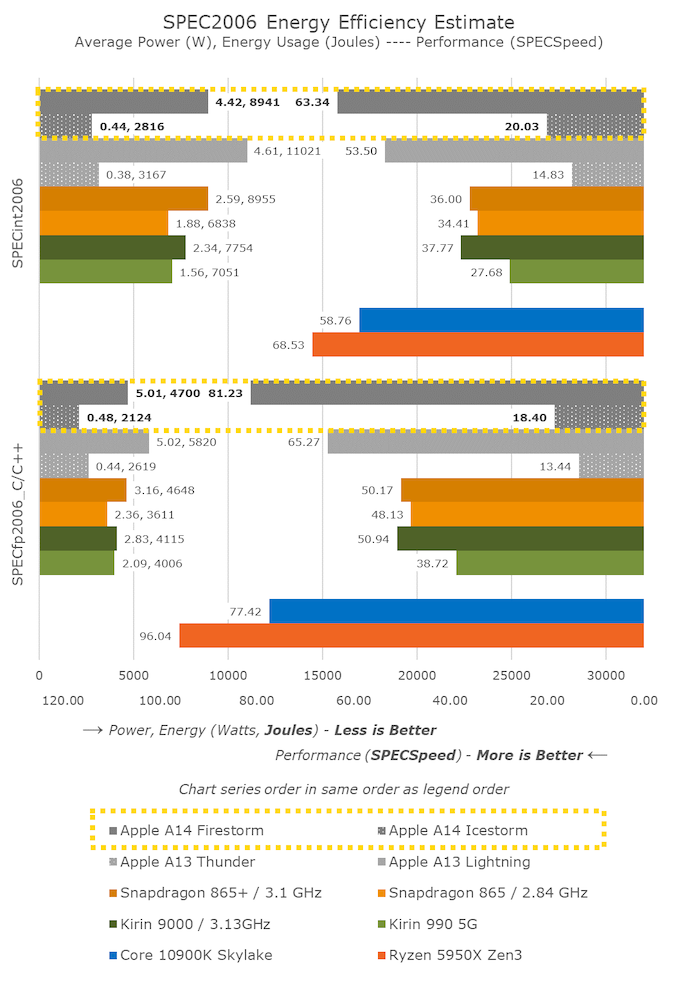Apple Announces The Apple Silicon M1: Ditching x86 - What to Expect, Based on A14
by Andrei Frumusanu on November 10, 2020 3:00 PM EST- Posted in
- Apple
- Apple A14
- Apple Silicon
- Apple M1
Dominating Mobile Performance
Before we dig deeper into the x86 vs Apple Silicon debate, it would be useful to look into more detail how the A14 Firestorm cores have improved upon the A13 Lightning cores, as well as detail the power and power efficiency improvements of the new chip’s 5nm process node.
The process node is actually quite the wildcard in the comparisons here as the A14 is the first 5nm chipset on the market, closely followed by Huawei’s Kirin 9000 in the Mate 40 series. We happen to have both devices and chips in house for testing, and contrasting the Kirin 9000 (Cortex-A77 3.13GHz on N5) vs the Snapdragon 865+ (Cortex-A77 3.09GHz on N7P) we can somewhat deduct how much of an impact the process node has in terms of power and efficiency, translating those improvements to the A13 vs A14 comparison.
Starting off with SPECint2006, we don’t see anything very unusual about the A14 scores, save the great improvement in 456.hmmer. Actually, this wasn’t due to a microarchitectural jump, but rather due to new optimisations on the part of the new LLVM version in Xcode 12. It seems here that the compiler has employed a similar loop optimisation as found on GCC8 onwards. The A13 score actually had improved from 47.79 to 64.87, but I hadn’t run new numbers on the whole suite yet.
For the rest of the workloads, the A14 generally looks like a relatively linear progression from the A13 in terms of progression, accounting for the clock frequency increase from 2.66GHz to 3GHz. The overall IPC gains for the suite look to be around 5% which is a bit less than Apple’s prior generations, though with a larger than usual clock speed increase.
Power consumption for the new chip is actually in line, and sometimes even better than the A13, which means that workload energy efficiency this generation has seen a noticeable improvement even at the peak performance point.
Performance against the contemporary Android and Cortex-core powered SoCs looks to be quite lopsided in favour of Apple. The one thing that stands out the most are the memory-intensive, sparse memory characterised workloads such as 429.mcf and 471.omnetpp where the Apple design features well over twice the performance, even though all the chip is running similar mobile-grade LPDDR4X/LPDDR5 memory. In our microarchitectural investigations we’ve seen signs of “memory magic” on Apple’s designs, where we might believe they’re using some sort of pointer-chase prefetching mechanism.
In SPECfp, the increases of the A14 over the A13 are a little higher than the linear clock frequency increase, as we’re measuring an overall 10-11% IPC uplift here. This isn’t too surprising given the additional fourth FP/SIMD pipeline of the design, whereas the integer side of the core has remained relatively unchanged compared to the A13.
In the overall mobile comparison, we can see that the new A14 has made robust progress in terms of increasing performance over the A13. Compared to the competition, Apple is well ahead of the pack – we’ll have to wait for next year’s Cortex-X1 devices to see the gap narrow again.
What’s also very important to note here is that Apple has achieved this all whilst remaining flat, or even lowering the power consumption of the new chip, notably reducing energy consumption for the same workloads.
Looking at the Kirin 9000 vs the Snapdragon 865+, we’re seeing a 10% reduction in power at relatively similar performance. Both chips use the same CPU IP, only differing in their process node and implementations. It seems Apple’s A14 here has been able to achieve better figures than just the process node improvement, which is expected given that it’s a new microarchitecture design as well.
One further note is the data of the A14’s small efficiency cores. This generation we saw a large microarchitectural boost on the part of these new cores which are now seeing 35% better performance versus last year’s A13 efficiency cores – all while further reducing energy consumption. I don’t know how the small cores will come into play on Apple’s “Apple Silicon” Mac designs, but they’re certainly still very performant and extremely efficient compared to other current contemporary Arm designs.
Lastly, there’s the x86 vs Apple performance comparison. Usually for iPhone reviews I comment on this in this section of the article, but given today’s context and the goals Apple has made for Apple Silicon, let’s investigate that into a whole dedicated section…













644 Comments
View All Comments
GeoffreyA - Saturday, December 12, 2020 - link
I tend to agree. You know, these technology companies of today are wielding great power in this world, yet it's not very visible perhaps. They control with a smile on their face. Chains work best when people don't know they're shackled.alpha754293 - Thursday, November 12, 2020 - link
With x86/x64 MacBooks, I can do more than just whatever Apple offers.Now, it's back to not really being able to do much with Macs again.
(It took probably close to a decade before technical computing apps were ported to MacOS on x86/x64. And now with this switch to ARM, guess that I won't be doing THAT anymore on any of the new Macs (since the apps, once again, aren't available, and hopefully, it won't take ANOTHER 10 years before the companies that make those programs, port them over. But then again, at least with x86/x64, they already had it for other OS platforms. This -- I'm not sure what any of the existing software vendors are going to do with this.)
samcolam - Friday, November 13, 2020 - link
Such an interesting thread.Tomatotech - Friday, November 13, 2020 - link
Lovely article. I read every word. Looking forward to actual reviews of the M1 soon.I think Apple has played a blinder here. Scores of millions of people have built up years of experience of using the iOS ecosystem to fill their wants. They are people who don’t mind paying extra for an iDevice. Now Apple is presenting them with the chance to transfer that experience to a laptop or desktop where they can run all their iOS apps (plus macOS apps.)
Now they don’t need to learn both iOS AND Windows or both iOS AND macOS. At work I see many people struggling with desktop OSes.
Apple has just said bye to all that. I’m old school IT, I can run 3 OSes on the same laptop without breaking a sweat, but that isn’t what the masses want, and it doesn’t help non-IT people achieve what they want. iOS & Android have done all that and more.
Google are trying with their Android-based chromebooks but it seems stuck at the low end for mass adoption. If Apple can deliver on this and it looks like they are doing so, their sales will soar.
MrCrispy - Friday, November 13, 2020 - link
You're talking about people with disposable income who want and can afford Apple's premium $$$ devices. Its not 'the masses', far from it. 'people who don’t mind paying extra for an iDevice' are first world rich people.There's nothing special about iOS or MacOS. They are sold based on hype and because its tied to the hardware.
btw Windows runs the same OS on everything from a wearable to a server and they did it years before anyone else. But Microsoft isn't 'cool' so no one talks about it.
Joe Guide - Friday, November 13, 2020 - link
There may be some truth to your comment. Apple's products can be more expensive, but if you match for performance to price, such as Dell's comparable computers, the difference becomes less.But now the game is flipped upside down. The new M1 chips seem unbeatable based on performance, efficiency and price. The base, cheapo, affordable MBA is proving to be world class.
Geekbench seems to suggest top single thread performance, and now actual performance on Affinity Photo suggests it's not hype.
https://twitter.com/andysomerfield/status/13268661...
Your point about iOS or MacOS being no better than Windows may be right. But you can't put Windows these new machines yet.
Silver5urfer - Friday, November 13, 2020 - link
Lol, unbeatable, please go to Apple.com and then click on Mac and see what Macbooks are priced higher, you know why Apple prices their devices higher or any company for that matter ?Performance / Features.
These new M1 Macs are not unbeatable dude, Macbooks running Intel are unbeatable because they compare with each other and not with Windows machines. Nothing is world class about this for many reasons
- Software is beta phase, there's no Adobe software ready as Apple M1 is just shipping to consumers but Adobe needs time to optimize, Office is announced but it runs slow due to Rosetta2, 32Bit x86 is dead with past Mac OS release, that puts many users who want a desktop OS, then ARM translation means this machine is not going to have a VM, it discarded Bootcamp. Then the OS ecosystem, Mac OS software is not equal to iOS, running iOS apps on mac is nothing ground breaking, iOS has gated filesystem vs Mac nope it is open, still leagues behind Windows and Linux, many normies are not going to mess with the Gateway to change the applicaiton installtion etc.
- Hardware, the Machine is costing over $1K+ and the RAM is 8GB, epic joke. And for SSD upgrade from 256 which is a joke at this price, is 200 bucks, and on top all is soldered. No one replace anything. Gaming performance is unknown at this point and Mac apps like SOTTR, BioShock needs to be updated for M1, then on top the Min spec for them is requiring a Dedicated GPU, so far AMD is not there, they are moving closer to their own ecosystem, there these games are not going to work. Geekbench is a shit benchmark, just hit GB4 scores on iPhones vs Android and then GB5 on the same and notice the difference with the SoCs on Apple vs Android, it's a worthless trash benchmark. The only viable is Cinebench R23 from Maxon. There ST is high but when we add SMT or here the BigLittle we do not know how perf scales, throttlng etc, since Mac Mini has fans while MBA the world class laptop doesn't, expect performance loss, no one can cheat physics. DIY repair is anyways dead on Macs since they removed the SSD and RAM, but with these and the Touchbar macs the KB is also sealed shut so is Battery heavily glued on.
Joe Guide - Friday, November 13, 2020 - link
You should read Paul Spector's assessment about where things stand. I think it is a fair analysis.https://componentplanet.wordpress.com/2020/11/13/b...
"By the same token, however, Apple’s marketing overreach on that stupid claim shouldn’t lull anyone into ignoring this chip. It represents the most potent threat to x86 dominance that I’ve seen in my entire career."
name99 - Friday, November 13, 2020 - link
Seriously?If an author can't tell the difference between 8 CPUs(+SMT) and 4 CPUs (+4 small) then he doesn't deserve my time.
NetMage - Saturday, November 14, 2020 - link
And if you can't tell the difference between Apple's low end passively cooled introductory chip, and what the future will bring, I think we know who's not worth any time.